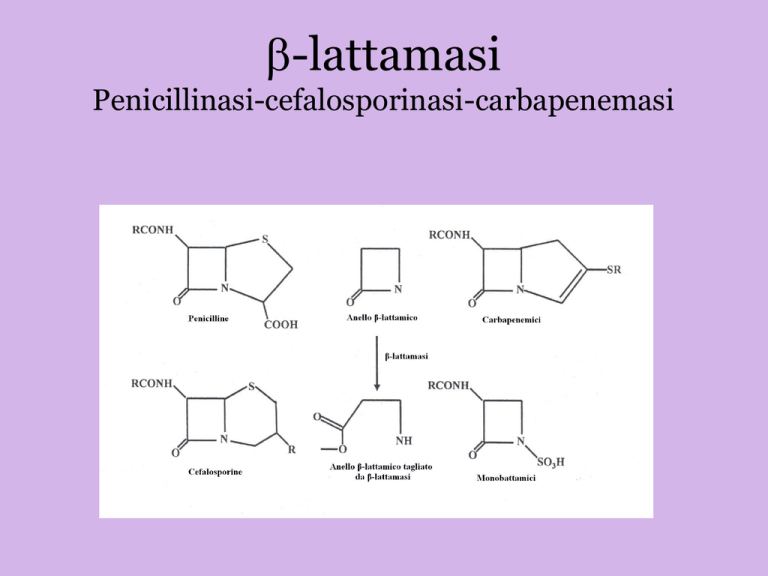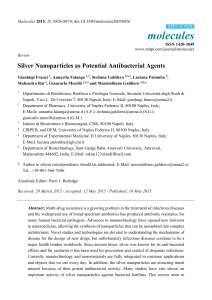
b-lattamasi
Penicillinasi-cefalosporinasi-carbapenemasi
b-lactamase
Clinically isolated distinct b-lactamase now
number > 1400.
The simplest classification is by protein sequence,
four classes, A, B, C, and D,
Classes A, C, and D include enzymes that
hydrolyze their substrates by forming an acyl
enzyme through an active site serine, whereas
class B b-lactamases are metalloenzymes that
utilize at least one active-site zinc ion to facilitate
b-lactam hydrolysis.
Inibitori delle β-lattamasi
Alcuni β-lattamici, derivati dalla ricerca di nuovi
antimicrobici, sono stati inizialmente scartati a
causa della loro modesta potenza antibatterica nei
confronti dei vari patogeni. Un numero ristretto di
queste molecole è stato in seguito identificato
come capace di legarsi in modo covalente alle βlattamasi. Attraverso tale meccanismo l’enzima
viene catturato e reso indisponibile per inattivare
l’altro eventuale farmaco presente.
Inibitori delle β-lattamasi
Gli inibitori suicidi oggi in uso sono:
acido clavulanico, trovato in colture di
Streptomyces clavurigerus, tazobactam
che è un sulfone dell’acido penicillanico
e sulbactam che è un 6desaminopenicillino sulfone. Questi
composti sono abbinati a penicilline o
cefalosporine garantendo loro immunità
dalle più diffuse β-lattamasi.
Inibitori delle β-lattamasi
Ac. clavulanico, inibisce le più diffuse βlattamasi incluse le ESBL che derivano da
Tem-1.
Sulbactam, è un inibitore a spettro più ampio
del clavulanato, ma meno potente, non è
induttore
Tazobactam, simile a sulbactam ma potente
come il clavulanato, non è induttore.
Currently available b-lactamase inhibitors are effectively limited to many
class A b-lactamases, excluding the KPC carbapenemases.
Ceftolozane--tazobactam
CXA-101 (oxyimino-aminothiazolyl cephalosporin) + tazobactam (beta-lactamase
inhibitor) (2:1 ratio)
Microbiology Coverage •P. aeruginosa (MIC90 = 1-8 μg/ml)
•CXA-101 is not a substrate of the MexAB-OprM, MexCD-OprJ, MexEF-OprN, and MexXY
efflux pumps nor the carbapenem-specific porin OprD in P. aeruginosa
Spectrum Gaps •Bacteria producing metallo-lactamases and certain ESBLs (OXA-15 and OXA11, -14 and 16) confer losses of CXA-201 activity (MIC >32 μg/ml); derepression of ampC in P.
aeruginosa can increase MIC up to 8-fold; MIC90 vs. MDR P. aeruginosa of >64 μg/ml
•Ceftazidime-R E. coli, K. pneumoniae ceftazidime-R or KPC producers, Enterobacter, Citrobacter,
ESBL+ Proteus spp. (MIC90= 16/>16/>16/>16/>16 μg/ml)
•No activity against MRSA and other key gram-positives
IV only
The addition of tazobactam at 8 μg/ml resulted in restoring the susceptibility of 93% of the
ESBL producers and 95% of the AmpC overproducers. Tazobactam was unable to lower
MICs, however, for Enterobacteriaceae producing KPC carbapenemases
Molecole in evoluzione
Tra gli inibitori suicidi che non includono i
beta-lattamici vi sono acido boronico,
fosfonati (poco stabili e sensibili alle
fosfodiesterasi) e diazabiciclo octanoni
Avibactam inibisce B, C e D betalactamasi, ma non le metallo betalattamasi.
E’ in fase di sperimentazione clinica
Avibactam
DBO
diazabiciclo octanoni
Avibactam has an extremely
broad spectrum of activity
against classes A and C serine
b-lactamases, including ESBLs
and class A carbapenemases
This molecule inhibits selected
class D b-lactamases including
OXA-48, but apparently not
other class D carbapenemases,
as judged by the absence of
synergy with imipenem against
resistant
strains
of
A.
baumannii producing OXA-51
and OXA-58 and does not
inhibit class B MBLs.
Ceftazidime-avibactam
Microbiology •Covers ESBL-producing
Enterobacteriaceae and P. aeruginosa isolates
producing class A and C β-lactamases,
including KPC producers as well as AmpCoverexpressing strains
Spectrum Gaps •Not active against bacteria
producing metallo-lactamases, OXA or VEB
ESBLs, OXA carbapenemases in A. baumannii,
NDM-1 producers, and efflux-mediated
ceftazidime resistance in P. aeruginosa
IV only
Ceftaroline - avibactam
•Gram-positives: MRSA, VRSA, MRSE, VRE ( E. faecalis, ampsensitive), S. pneumoniae, S. pyogenes
•Gram-negatives: H. influenzae, M. catarrhalis, ESBL-producing
Enterobacteriaceae, wild type Acinetobacter, KPC-producers
•Atypicals: No coverage
•Anaerobes: No, requires combination with metronidazole Spectrum
Gaps: Acinetobacter producing OXA β-lactamases ,
Enterobacteriaceae producing metallo-β-lactamases, P. aeruginosa
producing AmpC or with reduced outer membrane permeability,
amp-resistant E. faecalis
Mutant Selection: Frequencies for stable mutants from 25
enterobacteria with ESBL, AmpC or KPC β-lactamases were mostly
< 10-9
IV only
Aztreonam-Avibactam
Monobactams are
hydrolyzed by ESBLs
but are inherently
stable to hydrolysis by
MBLs, an avibactamaztreonam
combination resulted
inhibitory to MBLproducing pathogens.
MK 7655
MK-7655, a new member of the
DBO series. A combination of
imipenem and MK-7655 has
excellent activity against a KPC2-producing isolate of K.
pneumoniae
and
displays
moderate improvements in the
imipenem efficacy against most
AmpC-overexpressing isolates
of P. aeruginosa.
Imipenem-MK7655
Spectrum with Imipenem
•Gram-positives: streptococci, MSSA, MSSE, non-VRE
•Gram-negatives: At 4-8 μg/ml MK-7655, imipenem MICs of all strains were
below the resistant breakpoint of IPM for Pseudomonas and Klebsiella
containing KPCs
•Atypicals: No coverage
•Anaerobes: Coverage of B. fragilis and others Spectrum Gaps: VRE, MRSA,
Stenotrophomonas spp., Burkholderia spp. strains containing class D
metalloproteases; high levels of AmpC or KPC; certain class A βlactamases Mutant Selection: 10-8 - 10-9 for 2 isolates of P. aeruginosa; 2
x10-7 to <3 x 10-8 for KPC+ K. pneumoniae for imipenem + MK-7655
IV only
Preclinical Findings
•Restored activity of imipenem to kill rapidly
•Low protein binding (20%)
RPX7009
RPX7009, a boronic acid-containing lactamase inactivator with inhibitory
activity against class A and class C
serine -lactamases, particularly
highlighting both in vitro and in vivo
activity against KPC-producing K.
pneumoniae. Boronic acid inhibitors
of PBPs and of classes A, C, and D lactamases had previously been
identified, but none has achieved
success as a clinical candidate.
Preclinical testing of RPX7009
indicated that the inhibitor had no
off-target effects, and it was well
tolerated at high doses, with no safety
signals that would preclude future
development
Biapenem-RPX7009
Biapenem (“RPX- 2003”) is a broad-spectrum
carbapenem with in vitro activity against Gram-negative
and Gram-positive bacteria similar to that of meropenem.
Like other carbapenems, biapenem is not affected by the
presence of ESBLs but is labile to hydrolysis by both
serine and metallo-carbapenemases. Although
carbapenem resistance is increasing, 75% of recent
Japanese pseudomonal isolates were susceptible to
biapenem and meropenem. Pharmacologically, biapenem
is notable for its low proconvulsive activity compared to
that of imipenem
Carbapenem + carbapenem
A combination of ertapenem and doripenem in both an in vitro chemostat
and an in vivo murine thigh infection model. Overall, the combination of
doripenem plus ertapenem demonstrated enhanced efficacy over either
agent alone (2011)
Double-Carbapenem Therapy Not Proven To Be More Active than
Carbapenem Monotherapy against KPC-Positive Klebsiella pneumoniae
(2012)
Ertapenem plus doripenem or meropenem were given in three patients
suffering from pandrug-resistant, KPC-2-positive Klebsiella pneumoniae
bacteremia (2 patients) and urinary tract infection (1 patient), respectively.
All responded successfully, without relapse at follow-up. The results
obtained should probably be attributed to ertapenem’s increased affinity
for the carbapenemases hindering doripenem/meropenem degradation in
the environment of the microorganism (2013)
Enzimi autolitici
La lisi cellulare ottenuta con le penicilline non è
dovuta alla semplice inibizione della sintesi del
peptidoglicano ma all’induzione di enzimi:
un’amilasi che scinde i legami tra i tetrapeptidi e,
una glucosilasi che scinde il glucano.
Quando questi enzimi sono inattivati o per
mutazione o per crescita dei batteri a basso pH, la
penicillina ha effetti batteriostatici.

